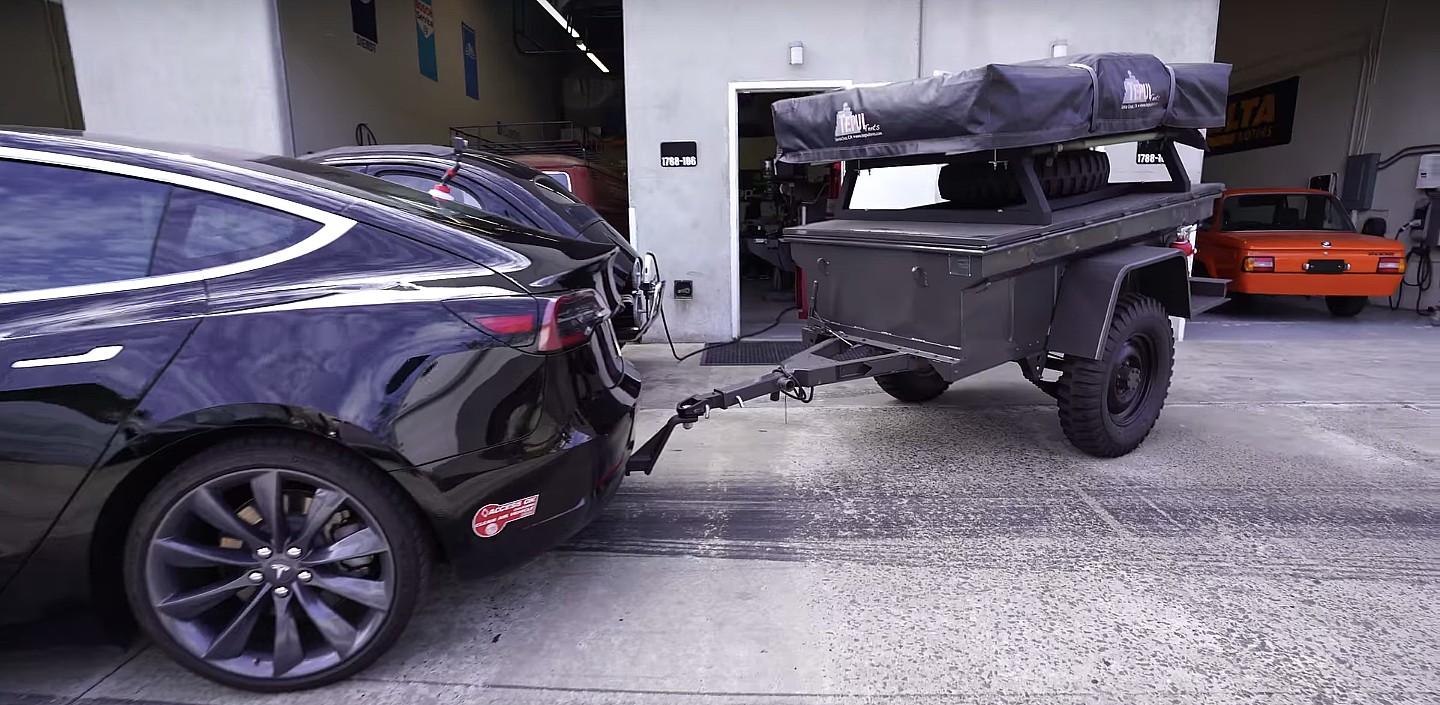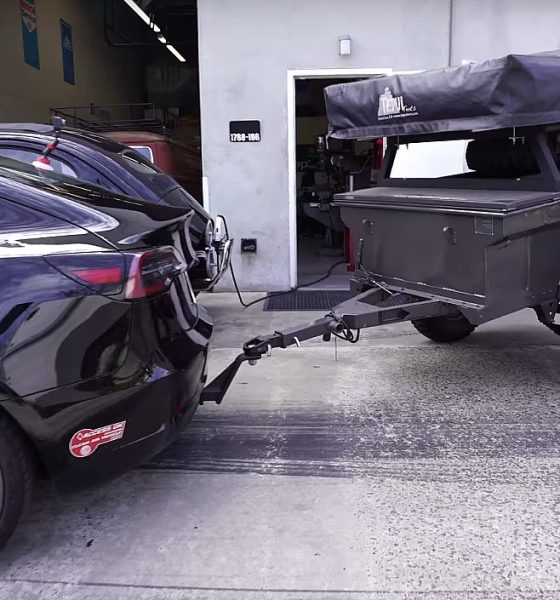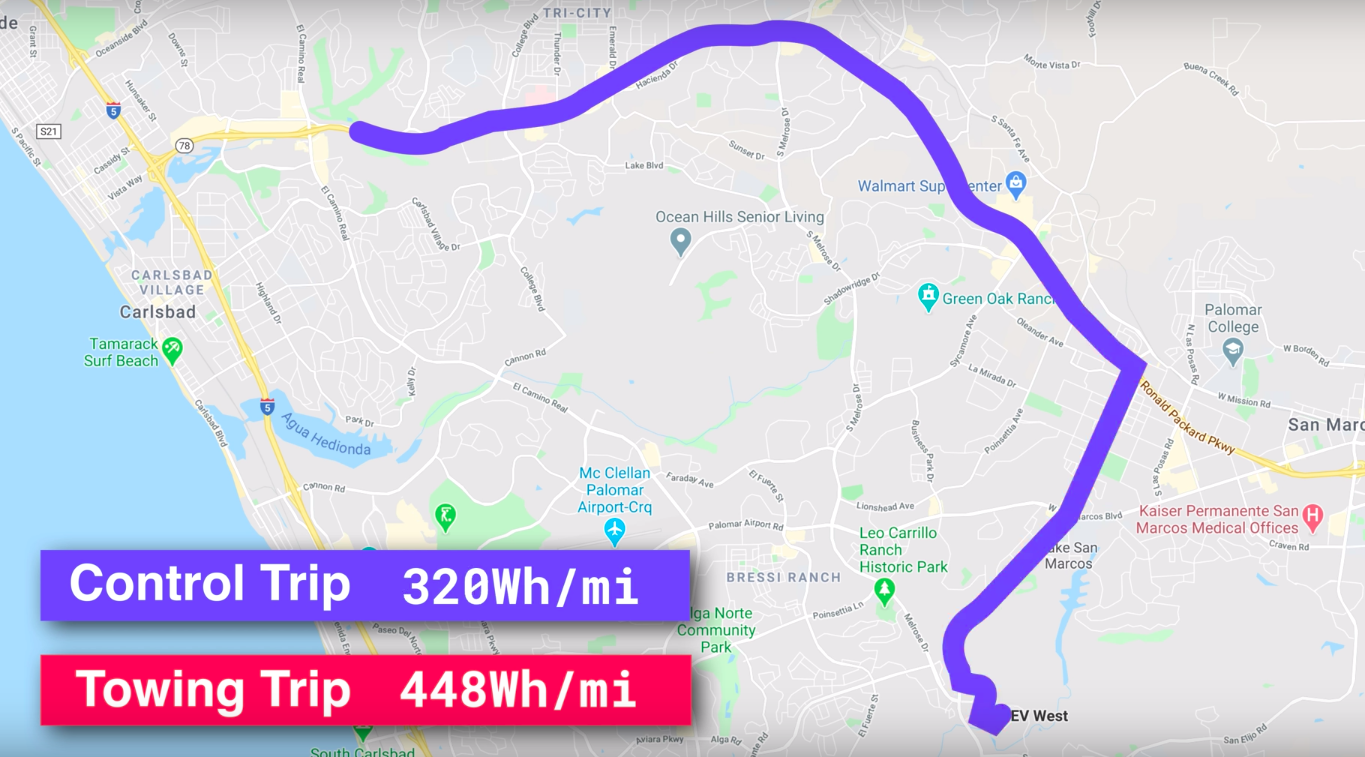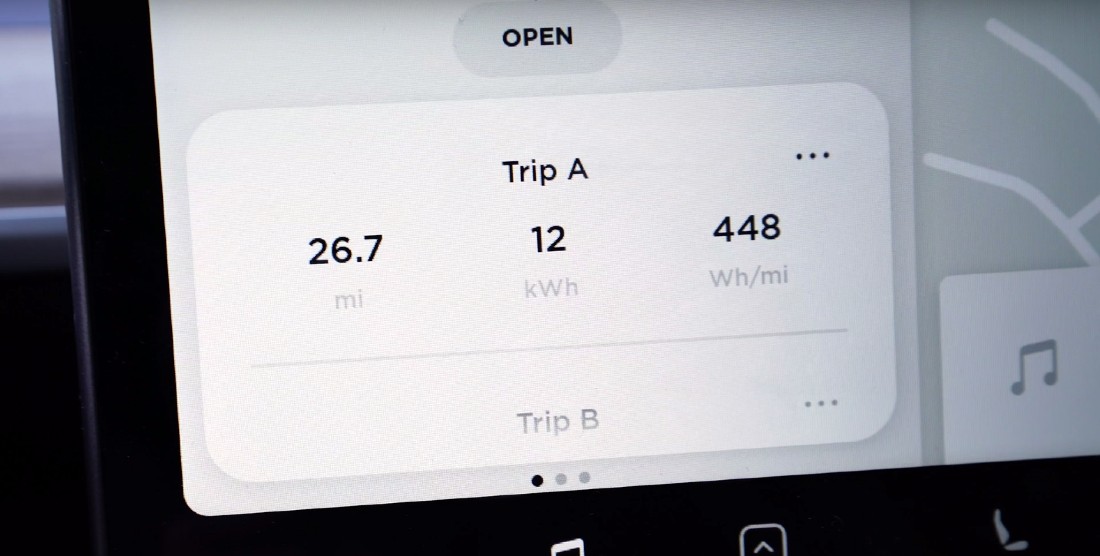

Lifestyle
Tesla Model 3 takes on World War II-era trailer in range efficiency towing test
A video showing a Tesla Model 3 towing a 550-pound trailer recently provided a glimpse at how real world range is affected when the all-electric sedan pulls heavy items.
The real-world Model 3 towing test was conducted by Ben Sullins of the Teslanomics YouTube channel. Ben’s channel is known for reviews and lifestyle videos with electric vehicles, and this time he decided to clarify the many questions EV owners have about the real-world effect on range when towing with the Model 3.
Sullins’ Tesla Model 3 is officially rated with 325 miles of range, but his real-world average efficiency of about 78% usually meant that his vehicle is only able to travel about 253 miles per charge. It is essential to keep in mind that the range of an electric vehicle depends on several variables, including driving style, weather, climate control within the vehicle’s cabin, and weight inside the car. When more features of the vehicle are in use, the battery is going to be under more stress. More use of vehicle features will inevitably decrease the range.
The trailer used in the test is a converted World War II work truck or jeep that weighs 550 lbs. The trailer was stacked with an outdoor fold-out tent and its necessary rack for use that weighs an additional 200 extra pounds, making the total weight of the trailer about 750 lbs. Sullins’ total trip covered 26.7 miles of both inner-city streets and freeways both ways. This gives the test more validity as drivers likely use a combination of highways and city streets when towing a trailer.
Sullins noted that his total energy usage during the test was 12 kilowatt-hours (kWh), and his vehicle showed an average consumption of 448 Watt-hours per mile (Wh/mile). This energy output differs from his normal driving efficiency, as his car showed an average consumption of 320 Wh/mi when it traversed the same route without a trailer.

These figures suggest that the additional weight from the trailer resulted in a 40% loss in range, which translates to a 49% efficiency rate. With this in mind, Sullins noted that with the 750-lb WWII trailer, his Model 3 would have a total real-world range of 160 miles. This is ample for the casual weekend camping trip, but likely challenging for inter-state long-distance travel.
As the Teslanomics host emphasized, there are many variables involved when it comes to electric vehicles and their efficiency. The Tesla Model 3 in the video, for example, seemed to be equipped with Turbine Wheels, which are larger and not specifically designed for the Model 3. The average speed of the vehicle during the trip also played a factor in the Model 3’s efficiency while towing. As noted by commenters on Sullins’ video, electric car towing veterans from countries such as Norway usually travel at about 55 mph when they are pulling heavy loads to help maximize range.

While this decrease in range is expected and inconvenient, there are plenty of precautions Tesla drivers can take to avoid the troubles that come with towing. Luckily, Superchargers are readily available, and Tesla has worked diligently to increase the presence of charging stations across the world.
If a trailer or other item that needs to be towed is attached to a Tesla, expect decreases in range and plan by stopping at Superchargers on the way. Tesla’s in-car trip planning software will get drivers to their destinations in the most efficient way possible, even if the vehicle is towing a heavy trailer.
Watch Ben Sullins’ video on the Model 3’s range when towing a 750-lb trailer below.

Lifestyle
Tesla Model S Plaid battles China’s 1500 hp monster Nurburgring monster, with surprising results
There is just something about Tesla’s tuning and refinement that makes raw specs seem not as game-changing.

The Tesla Model S Plaid has been around for some time. Today, it is no longer the world’s quickest four-door electric sedan, nor is it the most powerful. As per a recent video from motoring YouTube channel Carwow, however, it seems like the Model S Plaid is still more than a match for some of its newer and more powerful rivals.
The monster from China
The Xiaomi SU7 Ultra is nothing short of a monster. Just like the Model S Plaid, it features three motors. It also has 1,548 hp and 1,770 Nm of torque. It’s All Wheel Drive and weighs a hefty 2,360 kg. The vehicle, which costs just about the equivalent of £55,000, has been recorded setting an insane 7:04.957 at the Nurburgring, surpassing the previous record held by the Porsche Taycan Turbo GT.
For all intents and purposes, the Model S Plaid looked outgunned in Carwow’s test. The Model S Plaid is no slouch with its three motors that produce 1,020 hp and 1,420 Nm of torque. It’s also a bit lighter at 2,190 kg despite its larger size. However, as the Carwow host pointed out, the Model S Plaid holds a 7:25.231 record in the Nurburgring. Compared to the Xiaomi SU7 Ultra’s record, the Model S Plaid’s lap time is notably slower.
Real-world tests
As could be seen in Carwow’s drag races, however, Tesla’s tech wizardry with the Model S Plaid is still hard to beat. The two vehicles competed in nine races, and the older Model S Plaid actually beat its newer, more powerful counterpart from China several times. At one point in the race, the Xiaomi SU7 Ultra hit its power limit due to its battery’s temperature, but the Model S Plaid was still going strong.
The Model S Plaid was first teased five years ago, in September 2020 during Tesla’s Battery Day. Since then, cars like the Lucid Air Sapphire and the Xiaomi SU7 Ultra have been released, surpassing its specs. But just like the Model Y ended up being the better all-rounder compared to the BYD Sealion 7 and the MG IM6, there is just something about Tesla’s tuning and refinement that makes raw specs seem not as game-changing.
Check out Carwow’s Model S Plaid vs Xiaomi SU7 drag race video below.
Lifestyle
500-mile test proves why Tesla Model Y still humiliates rivals in Europe
On paper, the BYD Sealion 7 and MG IM6 promised standout capabilities against the Model Y.

BYD is seeing a lot of momentum in Europe, so much so that mainstream media has taken every opportunity to argue that the Chinese automaker has beaten Tesla in the region. But while BYD sales this year in Europe are rising and Tesla’s registrations remain challenged, the raw capabilities of vehicles like the Model Y are difficult to deny.
This was highlighted in a 500-mile challenge by What Car? magazine, which showed that the new Tesla Model Y is more efficient, cheaper to run, and more reliable than rivals like the BYD Sealion 7, and even the nearly 400 KW-charging MG IM6.
Range and charging promises
On paper, the BYD Sealion 7 and MG IM6 promised standout capabilities against the Model Y. The Sealion 7 had more estimated range and the IM6 promised significantly faster charging. When faced with real-world conditions, however, it was still the Model Y that proved superior.
During the 500-mile test, the BYD nearly failed to reach a charging stop, arriving with less range than its display projected, as noted in a CarUp report. MG fared better, but its charging speeds never reached its promised nearly-400 kW charging speed. Tesla’s Model Y, by comparison, managed energy calculations precisely and arrived at each stop without issue.
Tesla leads in areas that matter
Charging times from 25% to 80% showed that the MG was the fastest at 17 minutes, while Tesla and BYD were close at 28 and 29 minutes, respectively. Overall efficiency and cost told a different story, however. The Model Y consumed 19.4 kWh per 100 km, compared to 22.2 for MG and 23.9 for BYD. Over the full trip, Tesla’s charging costs totaled just £82 thanks to its supercharger network, far below BYD’s £130 and MG’s £119.
What Car? Magazine’s testers concluded that despite BYD’s rapid sales growth and the MG IM6’s seriously impressive charging speeds, Tesla remains the more compelling real-world choice. The Model Y just offers stability, efficiency, and a proven charging infrastructure through its Supercharging network. And as per the magazine’s hosts, the Model Y is even the cheapest car to own among the three that were tested.
Watch What Car? Magazine’s 500-mile test in the video below.
Lifestyle
Tesla Cybertruck slapped with world’s least intimidating ticket, and it’s pure cringe
One cannot help but cringe and feel second-hand embarrassment at the idea of a person just driving around with a stack of these babies.

A Cybertruck parked at Stanford Shopping Center in California was recently hit with what might be the most try-hard piece of paper ever slipped under a wiper blade: a “fake citation” accusing the driver of supporting a “fascist car.”
The note, shared on X by Tesla staff program manager Ryan Torres, quickly made the rounds on X, where it quickly gained attention as an example of how not to protest.
The world’s least intimidating ticket
According to the citation, the supposed “violation” was “driving a fascist car.” The remedial action? Take the bus, call an Uber, or ride a bike. The note also dubbed Elon Musk a “chainsaw-wielding Nazi billionaire.” Now, protests against Tesla and Elon Musk have become commonplace this year, but one cannot help but cringe and feel second-hand embarrassment at the idea of a person just driving around with a stack of fake anti-Tesla/Musk citations.
Torres pointed out the irony himself in his post on X. Tesla currently employs over 140,000 Americans, and SpaceX has put the U.S. firmly back at the top of space technology. As Torres put it, maybe the person behind the world’s least intimidating ticket should “read a book on innovation before vandalizing” other people’s property.
Peak performative clownery
Not to mention that the fake ticket’s logic collapses under its own weight. EVs like the Cybertruck are literally designed to reduce emissions, not “destroy the economy.” If anything, Tesla has bolstered the United States’ economy by fueling jobs in engineering, manufacturing, and clean energy. It’s not the first time a Tesla has been the target of vandalism or politically charged notes, but this one stands out for sheer cringe value.
Torres summed it up neatly: “Peak clownery.” On that point, at least, the citation earns full marks. In a way, though, perhaps cringe fake tickets are not as bad as the literal firebombs that were being thrown at Tesla stores and cars earlier this year because some critics were gleefully misinformed about Elon Musk.









